An odd week, and I have had many interruptions. But I will press forward, and if I do not finish on my own, we will finish together, over the weekend.
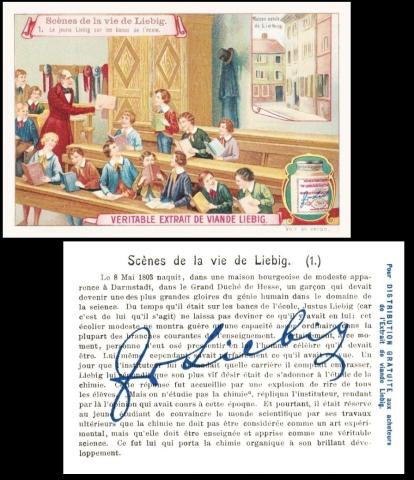
Liebig [trade : meat extract : O/S - South America] "Scenes de la vie de Liebig" / "Scenes from the life of Justus von Liebig" (1903) 1/6 - F.0749 : S.0737
So let us start our exploration with the fact that today, in 1870, the Elementary Education Act was given Royal Assent to become law.
This set up the system that provided, and enforced, the schooling of all children aged between five and twelve, right across England and Wales, and in urban and rural areas. It also set up local boards which were to acquire and control the public moneys that not only provided, but continued to support, those schools.
You may be wondering what about Scotland? The answer is that they already had universal education for all children, and had done so since a law was passed in 1633. However in 1872 this was updated to iron out many of the differences between the two.
The scheme was grand, but it was not always administered successfully. The first problem was that not all births were recorded, especially in rural areas. This led to a census being undertaken of all children between five and twelve, something that met with resistance and quite a bit of deception. There was also suspicion that if there were more children than private donations, the parents could be asked to pay, something quite impossible for a farmer, and something most unpopular with the rich. And lastly, especially in rural areas, those children formed a valuable workforce at certain times of the year, especially the harvesting, though with this there was a compromise, eventually, which is why we have such a long school holiday at the end of July to this day.
The law was drafted in 1870 by the Liberal M.P. William Forster, which is why you will sometimes see this act called the Forster Law, or Forster`s Education Act. Primarily he was after votes, for himself, from people who believed that poorer children should be educated equally as well as richer ones, but also for his party, from all the young children who would grow up and vote for them, thankful for their chance at learning.
He faced stiff opposition. This was mainly from the Tories, who felt that if you educated the poor there would come a time when they would rise against the upper classes. And, curiously, it was also from the Church, who not only feared the teaching of religion would not be so stringent in a general school, but who were also being given money from the state to educate the poor, and were adamant that they did not want to lose it, which seems to suggest that not all of it was being used as it was intended.
After the act was passed, it was amended, in 1876, to include a clause making attendance compulsory, or that proof of alternative, and equal, education be shown. It was also altered in 1880, dropping the maximum age, so that children could leave in the year that they were ten. Then, in 1891, any reference to paying for schooling was removed.
In 1902, this all changed, with the creation of Local Education Authorities to replace the local school boards. It also made education of a secondary level, from the age of ten, a legal requirement
This set tells the story of the life of the man behind the meat extract. Which we will also explore as we go along. I am not sure I will get to do a list of all the cards this week, nor the exploration, but they will appear one day. And I can start it with ours, for that is card number one :
- Le Jeune Liebig sur les bancs de l`ecole (Liebig at School) / insert : maison natale de Liebig (birth place of Liebig)
- Explosion in der Apotheke zu Heppenheim (explosion at the apothecary in Heppenheim) / insert : Apotheke Heppenheim
- Liebig dans son laboratoire de Giessen (Liebig in his laboratory at Giessen) / insert : L`Universite de Giessen
- Liebig est appelle chez le Roi Max de Baviere / insert : Chateau de Berg
- Liebig a la amphitheatre de chimie a Munich (Liebig lecturing on chemistry at Munich) / insert : Laboratoires de chimie a l`Universitie de Munich
- Usines de la compie Liebig a Fray Bentos (Liebig`s company works at Fray Bentos) / insert : Justus v. Liebig himself.
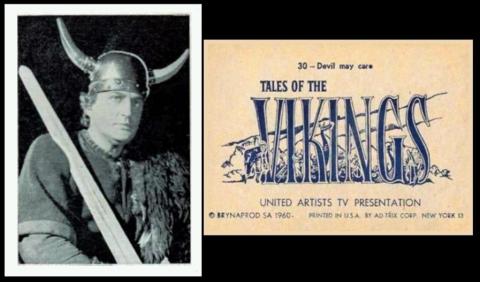
AD-TRIX Corporation [trade : USA - New York] "Tales of the Vikings" (1960) 30/66
Let us return even further back now, to today in the year 991, when, if you lived in Maldon, Essex, you might have seen someone just like this coming towards you. Though, before you get too excited, hear this. We are not sure if the events we are about to recant took place today, or tomorrow, or over an entire fortnight, or even if they occurred at all.
We base our entire knowledge on a much later poem, which tells of how the little town of Maldon was invaded, by Vikings, who came by ship along the river - and of how they beat the Anglo-Saxons, but were convinced not to take over the entire country for a mere ten thousand pounds of in weight of assorted Roman silver. Mind you this is almost two milliion pounds in money given the inflation and deflation which has intervened between.
There are discrepancies, which do not help, between the sections of the poem. The size of the Viking army varies immensely, as does the size and location of the English forces. It was also, for a very long time, not written down, just passed from reader to reader, which almost certainly involved changes and mishearings. It was written in Saxon, and we think it was written down, for the first time, in the eleventh century, by a scribe at Worcester monastery, which is rather far from the scene. Then it was bought, and sold, and traded for favours, and then entirely destroyed, by a house fire in 1731. Luckily, or so we suppose, the owner had begun to write some of the middle parts of it out again, though the top and bottom sections had already been removed, but we do not know if whilst he was doing that he was also changing, or embellishing it, adding in scenes that made his heart beat a little faster, or even writing an entirely new narrative based on that tale.
According to this, the Vikings came sailing up the river and the local nobleman, Ealdorman Byrhtnoth, came out, with his men. He was slowly followed by local farmers, on horses, and villagers, on foot. For some reason the farmers were told to dismount and release their horses back to the land.
The Vikings sailed past, then moored their boats at an island which was connected to the mainland. It seems that the idea of taking a pay off rather than invading originated with the Vikings, for even their name translates to raiding, to coming, and going if they were paid with enough to make it worth their while, coming back and back until the money, or precious metals, ran out.
However, in this case, the nobleman called their bluff, some might say foolishly, and told them his men would rather fight than pay. This led to the Vikings invading, and killing the nobleman, at which time a lot of the local men ran away; leaving a core group of personal friends and employees who fought on. And it appears that the Vikings lost many men to this little motley band, at last retreating rather than invade the country.
As for the Roman silver, we do not know. Ten thousand pounds is a very large weight to carry, and it is unlikely to have been brought to the field of war, even if it was laying around back at the nobleman`s fortress, just ready to be picked up.
As far as Vikings on cards, there are not so many. And if you hunt for trade cards you are inundated with aircraft and spaceships. What we did unearth though is that "Viking Navy Cut" was a brand name, for tobacco and cigarettes, used by Lambert & Butler, and registered as a trademark on the 26th of May 1899. You can see it advertised on the reverses of their coloured and black and white sets of "Admirals" (both issued in 1900) - and the latter tells us it was available in either mild, with a pink label, medium, with a white one, or rich and full flavoured, with a lavender one.
In a change to the card we began with, which turned out not to be a Viking at all, we now have this interesting one, which is a tie in to a television series, produced by United Artists in 1959. It was not issued with a product, it was circulated by way of vending machines.
There are also three versions, this black and white one, which is thought to have come first, but you can alsofind in printed in green, or sepia. They are pretty scarce though, and I am told that the best place to find them is at yard sales where they have been bundled up together in mixed lots, Of course, this is way more likely in America than the United Kingdom, few cards made it over here.
The most interesting thing to me is that the back mentions "Bryna Prod. SA", because it was an independent film and television production company founded by the actor Kirk Douglas. Bryna was his mother`s christian name, and as the business expanded he renamed it to The Bryna Company, splitting it into different parts and calling those after his sons. Now Kirk Douglas made many films, but one of them was "The Vikings", released in 1958, and co-starring Ernest Borgnine, plus Tony Curtis and his wife Janet Leigh. It was based on a book, a novel, published in 1951, but both book and film are actually recountings of the tales of an actual Viking, Ragnar Lodbrok and his descendants.
It was a box office hit, and so along came this television series, directed by Elmo Williams, who had edited the film. However, and sadly, none of the original characters or stars were carried on into it. As this set shows, it was also only very loosely based on Vikings, and they appear on few of the cards, which seems to cover a range of goings on from all different eras. There is also no descriptive text, which would have at least made sense of what the pictures represented, all we have is a rather joky title, and not always funny. That for our Viking is "Devil May Care", referring, I imagine, to the horns on his helmet. Not always funny, as I said.
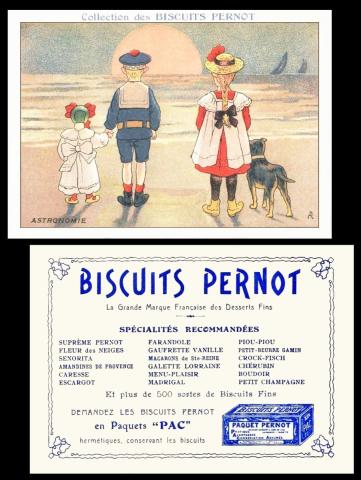
PERNOT [trade ; biscuits : O/S - France] - "L`Alphabet du Sciences" (1890s) A/26
This card is also rather borderline but to me it suggests this subject extraordinarily well, and quite poignantly, for today is the last day of the Dog Days of Summer, which are the hottest days of the year. They start, traditionally, during the first few days of July, and end in the middle of August, and they do vary every year, so this year we have run them from July the 3rd to the 11th of August.
In fact they are nothing to do with dogs, their name comes from the fact that they occur after Sirius, the "Dog Star" becomes what is known as "The Morning Star", in other words, the one which is seen first above the eastern horizon when the night turns into day. Or at least would have been before all the houses got in the way.
For some reason, and maybe because the early Greeks were jolly good at predicting weather, they presaged thunderstorms, heat, and the associated problems of humans and animals feeling hot and sleepy. And they marked the very middle of the year.
To return to our card, here we have a group of children, at the beach, at the end of summer. They may be a family, but they look more like friends, who have banded together every morning, and played until called back to their hotel. Now, the sun is setting on their holidays, and school is beckoning ever harder, however much they try to cast it from their minds. Once more, work, not pleasure, will be the order of the day.
And the dog, too, will go from having tons of fun - barking at lots of tiny humans, and chasing them down the beach, in and out of the waves, whilst they laugh and scream - to laying, boredly, on the hard cold floor of the scullery, with nothing to amuse him save perhaps the buzzing of a fly, or the scurrying of a mouse, come in from the cold. His dog days, at least for this year, will be over.
The most surprising thing about this card is that on the back it tells us that Biscuits Pernot has a range of "more than 500 sorts of fine biscuit". I would be hard pressed to think of any company today who could claim that...
Now I must admit that I did not know from which set this came, though I did, at first, think it an advertising card, until I saw it said "Astronomie" at the bottom of the front, and also had a capital letter "A", which is why I have classified it as the Alphabet of Science. However I then failed to find a card for any branch of science that I know of.
At this stage, along came Mr. Clarke, a reader, and collector of European cards, who started a biography of the company, which you will find with our Card of the Day for the 27th of January, 2022 - and to tell me it is a set of six cards - namely
- Astronomie [a boy, a girl, a dog, and a toddler watching the setting sun on a beach]
- Danse [four children dancing in a ring]
- Musique [a boy playing the accordion and three children and a dog watching]
- Peinture [a boy painting the hat of another boy with two girls]
- Sculpture [a boy building a snowman and two girls watching]
- Theatre [a boy operating puppets over the back of a chair, whilst a baby is held on the chair by a girl]
It was also issued more than once, as there are at least two different backs, these being :
- a list of biscuits - horizontal
- a boy looking at a sealed box - vertical
In addition the "A" is actually a logo, for the artist, who was called Michele.
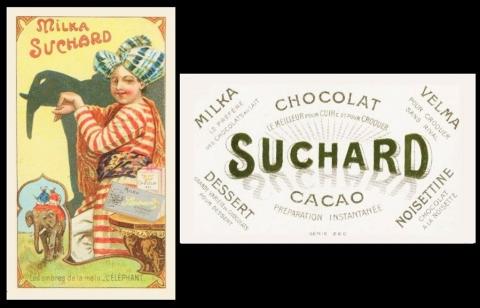
Suchard [trade : chocolate : O/S - Switzerland] "Les Ombres de la Main" / "The Shadows of the Hand" - Series 220 (1910?)
Today, so I am told by a reader, is #WorldElephantDay
These large creatures are not only kind and gentle, unless roused, mostly by humans, but this year we celebrate the fact that they are a matriarchal society, led by females, and especially by the older ones, whose vast memories are passed down through the generations to advise on secret food hoards, safe places to run to, and what happens if climate changes from year to year.
And we also note, with much respect, that it is mostly female researchers, rangers, and leaders who attempt to ensure their survival.
The strange thing is that with the elephant, and also with the killer whale, that the males seem to be born into accepting this. There are no males coming to try and muscle in, and they go off peacefully and band themselves together, far away from the female groups.
And, unless called on, they know that their assistance is not required.
This set is known by several names and some of them included "Chinois" which relates to the costume of the children, though, to me, that looks more Indian than Chinese. The other cards, or those I know of, anyway, are ;
- Chameau - camel
- Chamois - mountain goat
- Chat - cat
- Chevre - farm goat
- Chien - dog
- Cygne - swan
- Elephant
- Lapin - rabbit
- Perroquet - parrot
- Vache - cow
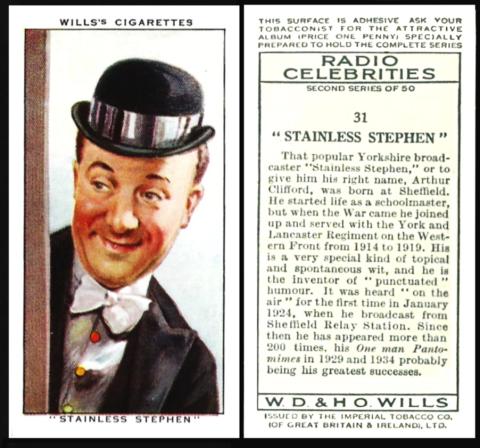
W. D. & H.O. WILLS [tobacco : UK - Bristol] "Radio Celebrities" - second series (July 1935) 31/50 - W675-240.2.A : W62-197.2.A : W/302.A
For some reason I clung grimly and immovably to the fact that today in 1913 saw Harry Brearley invent a substance that was named stainless steel. However finding a card of stainless steel, or any kind of cutlery, proved impossible for some time - and cards of Sheffield, where he came from, never thought to show a knife or fork anywhere. Even John Player`s "Counties and their Industries" picked worsted spinning and not cutlery making, which is odd, as they were issued in 1914 and 1915 (with the addition of card numbers), just at the time that stainless steel was new.
Then I had a breakthrough, with this card, which shows not just a man born, like stainless steel, in Sheffield, on November the 30th, 1892. Even better he was known as "Stainless" Stephen, as his stage name, anyway, and he reinforced this by having a wide stainless steel band around his bowler hat, as you can see on this card. And he had another, even less well known, pseudonym, of "Oscillating Oscar".
His real name was Arthur Clifford Baynes, and he appears as "Arthur Clifford" on both a postcard, issued by the "Radio Pictorial" magazine, and on card 13 of John Sinclair`s "Radio Favourites". Both these cards use the same portrait. The text of the Sinclair card tells us that : "Stainless Stephen is a native of Sheffield, which accounts for his name - he explains that it is alliterative, and reminiscent of the staple product of his native town. His real name is Arthur Clifford. He joined the army in 1914, and it was while he was learning signalling that the idea for his particular brand of humour occurred to him. In 1919 he began to work on the music-halls, and was billed as Arthur Clifford (comma) Comedian (question mark). His humour is topical and spontaneous. The greatest honour paid to him was when he was chosen by the British Legion to entertain the Prince of Wales and the Alllied Commanders prior to the dedication of the Menin Gate." It then says "Issued by permission of Radio Pictorial", which explains why the pictures are identical. And I wonder how many other pictures in this set are akin to both the Sinclair cigarette cards and the Radio Pictorial postcards.
Little seems known of his early life but his service in the First World War was with the Sheffield City Battalion of the York and Lancaster Regiment - and he was wounded twice, which I ought to be able to track down in the papers. Most references say that he was not demobbed until 1921 and yet the Sinclair card has him beginning to work on the music halls in 1919.
We know that in 1922 a job offer came along, as a teacher of English at Crookes Endowed School. He loved learning, and also he loved the complexities of the English Language, so teaching was the best possible job, and it took so much precedence in his life that he would not allow himself to perform on stage in term time.
Then, at weekends, he went off cycling, at which he was very good, and even won medals.
It was not until 1930 that he first appeared in a London performance, and he quickly became so popular that he was voted the most popular radio artist of 1932. It was only then that he thought he would like to try to become a full time entertainer, gave up his teaching job, and moved to London.
His "gimmick" was to deliver a monologue, but as the Sinclair card tells us, to include the punctuation marks as words amidst the flow. It was actually very hard to do, much harder than his audience probably realised. Some people do have a knack for this sort of thing, or to be able to convert a sentence into purely its initials straight off the bat. I try, and fail, and am admiring of those who can.
By the time of the Second World War he was able to join the tours with ENSA, the entertainment arm of the forces. He did this throughout the war, even touring India and the Far East.
He retired in 1952, and moved to Chiddingstone, in Kent, where he ran a farm, where he died, in 1971, aged seventy-eight.
This set, at one time, seemed too be everywhere, but it is getting scarcer. I have no reason for its disappearance from the collecting scene, unless the people in it have become unknown to modern buyers, and they are noyttrhtf but if you read the description in our original Wills reference book, you discover that four sets carry this name, and look alike, That entry reads :
- RADIO CELEBRITIES. Fronts printed by letterpress in colour. Backs in grey, with descriptive text, adhesive, Special album issued.
301. 50. "A Series of 50". Issued 1934. Varieties occur at Nos. 7, 9, 10, 22, and 31
A. Home issue, backs headed "This surface is......"
B.Irish issue, backs headed "Note - This surface...."
302. 50. "Second Series of 50". Issued 1935. A variety occurs at No. 27
A. Home issue, backs headed "This surface is......"
B.Irish issue, backs headed "Note - This surface...."
When the dates of issue appeared in the Wills` Works Magazine, we were able to record that the home issues began to be circulated in August 1934 and July 1935.
It also appears that the second series may have been intended to follow straight on from the first, but it was bounced by sets that commemorated two unexpected newsworthy events. The first of these was the new "Road Traffic Act", made law on the 31st of July 1934, which set a maximum speed limit in built up areas to 20 m.p.h., and introduced many other motoring rules and regulations, leading also to the set of "Safety First", which was issued in December 1934. And the second one was the Silver Jubilee of King George V, which led to the issue, in April 1935, of "The Reign of King George V". That meant our second series was not released until July 1935.
However the issue dates of the Irish versions were never recorded in the Wills` Works Magazine, which means they were printed here, and sent to Ireland for circulation. And that is a great shame as we do know that the set for the Silver Jubilee was only a home issue, not circulated in Ireland, and it is possible that our second series was issued three months earlier than it was at home.
Before I gallop on, the error on card number 27 of this second series adds even more complexity, as it is of John Tilley - and the second, later version not only adds "The Late" before his name at the top of the reverse, but adds a new line at the end of the text, namely, "He died in August, 1935". Now we know that he had not been in entertainment that long, only beginning in 1932, and that he fell ill in 1934, which made it difficult for him to continue his career, and resulted in an operation on his kidneys. Then he died, in Hemel Hempstead, on the 3rd of August, 1935.
This also points to the second series being readied in 1934, when he was still entertaining, rather than in 1935, when he was ill. So that seems to suggest that the set was printed and ready to release, and then held back, and that shortly after the actual release he died and the one card was reprinted and re-issued.
And, by the way, both versions are identical on the front, and both say John Tilley. It is only when you turn them over that you see the alteration.
Now when the original World Tobacco Issues Index was published there had been some changes to the listing in the original Wills books, most notably the lists of varieties, which no longer appeared. Though there was a link back to those original volumes. The entry reads ;
- RADIO CELEBRITIES. Sm. Nd. See W/301-2 ... W62-197
1. "A Series of 50".
A. Home issue, back "This surface is......"
B.Irish issue, back "Note - This surface...."
2. "Second Series of 50".
A. Home issue, backs headed "This surface is......"
B.Irish issue, backs headed "Note - This surface...."
And that is the same wording as in our updated version of the - with a new card code, of W62-197
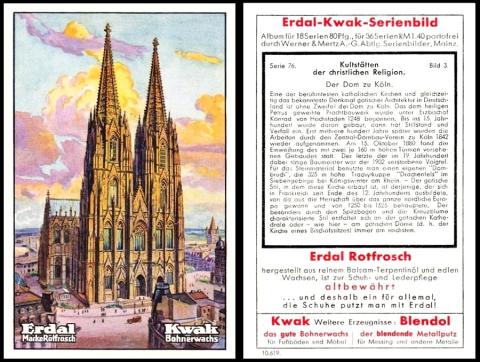
Werner & Mertz [trade : shoe polish : O/S - Germany] "Cathedrales" (1920s) Serie 76, picture 3/6.
Today saw Cologne cathedral completed, after about six hundred years.
Work on this building started in 1248, and the foundation stone was laid on the 15th of August. Work continued through until 1473. Some time before this, a giant, but rudimentary crane had been erected on top of the tower, and that stayed in place until 1883. There were a few false starts, right up until 1560, after which nothing was done at all until 1814, and that took right until the 15th of October, 1880 to be considered finished enough to hold a ceremony with the German Emperor, Wilhelm I, in attendance
At that time it was the tallest building in the world. It remains the tallest double-spired church in the world, and the third tallest religious building in the world too. And, surprisingly, for a religious building, it is the most visited tourist attraction in Germany.
This set is quite hard to track down and I can only find :
- Der Dom zu Koln [Cologne]
- Die Basilius-Kathedrale in Moskau [Moscow]

W.D. & H.O. WILLS [tobacco : UK - Bristol] "Donington Collection" (1993) Un/30 - W675-262.1
Now if i speed up I may actually finish. And that is a neat link to the fact that today in 1947 Ferrari made their racing debut.
I have not been able to find a card of the driver, Franco Cortese, nor of the actual car, which was a 159 S - the "S" standing for Sport. And the race took place at the Circuito di Pescara, which is very unlikely to appear on a card.
In fact the car did very well, coming home second, though it actually led the race for some time. And it did get a win, at the Turin Grand Prix on October 12, but with a French driver, Raymond Sommer, behind the wheel.
The car on this card is a Ferrari 125, but not the S class, though it does date from not long after, as it was the winner of the Czechoslovakian Grand Prix in 1949. It was not an official Ferrari entry either, it was owned and raced by an Englishman, who was therefore able to paint it whatever colour he liked. And this is now in the Donington Collection.
As far as the 125 S, that was sold not so long after it won the Turin Grand Prix, to a pair of enthusiastic Italian brothers, who radically converted it and raced it throughout the late 1940s. They kept it for a long time after that and it finally emerged on to the open market at an auction in 2004, when it was bought by a fellow Ferrari lover, and he still races it.
This set was issued with cigars, and again there are two versions, recorded only in our updated World Tobacco Issues Index as :
- DONINGTON COLLECTION ... W675-262
A. Md. 85 x 55 (30)
B. Lg. 124 x 86, rounded corners. Drip mats. Skipped numbers (6)
At which point I can tell you that our car was one which did not make the mats. And when I am able to use a mat I will reveal the cars which did.....
This week's Cards of the Day...
spoke of something that we seldom do, and that is #NationalUnderwearDay, which this year falls on August the 5th.
Actually there is a really thoughtful reason for the day, and that is to demonstrate that beautiful underwear is not just restricted to svelte, tall, models, it ought to be shown off by anyone, of any size, shape, form, or disability, even if it is only to yourself, looking in the mirror with approval. And it encourages you to treat yourself to something new, and maybe even different, just to make you feel good.
Our first two clue cards should have led you to two of the most common types of underwear, which were ...
Saturday, 2nd August 2025
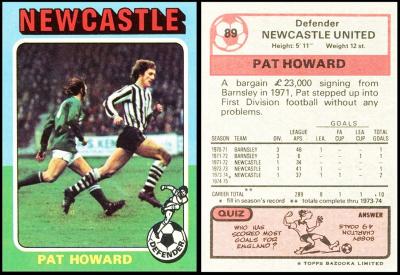
Now though our card shows the type of thick cloth shorts being sported by footballers - even though this is the 1970s, and they are rather skimpy ones - in an underwear context "shorts" are most usually worn by women.
They are larger than briefs, but still not too high across the stomach, and they are one of the most comfortable of all designs.
And you will often find them used, but slightly thicker and more patterned, as the bottom halves of summer pyjamas.
Patrick Howard was born on the 7th of October 1947, in Dodsworth, part of Barnsley, which was his first football team.
He then moved to Newcastle United in 1970/71. During that time he appeared on his first card, a rather odd, blank backed series, that some collectors do not even consider cartophilic. It was issued by Marshall Cavendish publications as part of their "Book of Football", a part work, complete in seventy-five parts. These parts were sold at newsagents for 23p each, or you could be profligate and buy the whole lot, to be delivered to your address also as a partwork, over twelve months, for £13.30, including postage and packaging. Now the first twenty of those parts came with an added bonus, these "Colour Star Portraits", sheets of which formed the centre spread, and were then to be cut out by the recipient, and put in a special album which was included with the second issue, or, if you missed that, bought for 25p, including postage and packaging. Do note that there are only three hundred and twenty cards - a completed album does indeed have three hundred and sixty four portraits, but forty-four of those are actually pre-printed.
Pretty much all the cards ever issued of him show him in that Newcastle strip. This changes in 1977, when he appeared in an orange and red outfit, as part of the Americana "Football Special 1977-1978". These cards are actually stickers, and they have a section where you can peel a shaped part off the front and stick it in the album. The backs that remain have the player`s name on the back, and their team, and our man`s reputedly says Arsenal, though this is quite unlike any Arsenal strip I ever saw. However, Newcastle had indeed sold our man to Arsenal in 1976, though he was soon transferred out, back north, to Birmingham City. Now I checked up on them, but they played in blue. I also checked out the Portland Timbers, to whom, in 1978, Birmingham City loaned him out. They were an American soccer team, based in Oregon, North America, and were founded in 1975, but only lasted until 1982. So if anyone recognises that rather lairy orange attire, and can tie it to a team, please let us know. Or if you have that sticker and can just read off what it says, because even the trading card database does not show the back in the case of our man.
America was either not to our man`s liking, or it was only intended to be a short loan. He lasted out the year with them, but was back in England, with Bury, for the 1979 season, and it is not their strip either.
He retired in 1982, and presumably is still alive, though I can find nothing else about him.
This set currently only appears in our original British Trade Index part three, as :
- FOOTBALLERS - 1975. (A). 89 x 63. Back "Topps Bazooka Limited". Latest dating on backs is "Season 1974-75". ... TOH-3
1. English edition. Back in red. Nd. (220)
2. Scottish edition. Back in blue. Nd. (88)
This is not actually correct as the English edition was of two series.
The first of these was numbers 1 to 132, including a sub-series called "Double Centurions" (cards 64 to 68 - Ron Davies, Ken Wagstaff, Kevin Hector, Francis Lea, Geoff Hurst).
Whilst the second series being of eighty-eight cards, numbered 133 to 220, and including a sub-series called "Great Britain Select Eleven" (cards 190 to 201 - which unfortunately starts with a typo, "Mike" Channon, not Mick, then continues through Malcolm MacDonald, Leighton James, Colin Todd, David Nish, Emlyn Hughes, Phil Thompson, Billy Bremner, Colin Bell, Alan Hudson, Peter Shilton, and Paul Madeley).
Sunday, 3rd August 2025
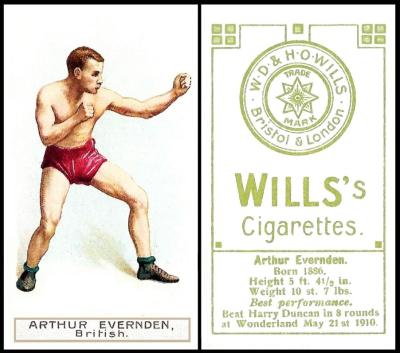
Now there is much debate as to when the word "boxers" was applied to this type of underwear, and some sites put the first English usage to as late as the Second World War, when it was heard from the mouths of visiting G.I.s.
We definitely know that it was an American word, and legend has it that it refers to the time when the old thick material shorts which needed to be supported by leather belts, were replaced by more modern ones with elasticated waists - and that to differentiate between the two, the newer style were advertised as modern boxer shorts.
Arthur Evernden was born in 1886, in Erith, Kent, and boxed between 1908 and 1920, some sixty-nine bouts, of which he won thirty-nine.
His first match was at the Camberwell Public Baths, opened in 1892 as a place for local men, and also ladies, in a separate area, simply to take a bath, or do their laundry. The baths were sorely needed, as many of the local homes did not have baths, or a place to hang out washing. When it came to winter, the swimming pool section was deemed unnecessary, and it was closed, but it was soon decided that instead of leaving the space unused, a floor could be laid above it and it could be used for other sports and entertainments. The first boxing match was in 1908, but I am not sure if Mr. Evernden was involved in that, because his match took place late in the year, on November the 30th, against a fairly local opponent, Bert Langford of Deptford.
This card mentions. that was on May the 21st, but not that Harry Duncan was from Holloway, nor that this "Wonderland" was in Whitechapel. There was another, in Paris, where he fought a man called "Eustache", on March the 18th, 1911. Mr. Evernden was a regular at the Whitechapel "Wonderland", and first fought Aschel "Young" Joseph, from Aldgate, there - on June the 11th, 1910.
On January the 23rd, 1911, our man reportedly won the British Welterweight Championship, at the Ring, in Blackfriars, beating the current holder, who was Aschel "Young" Joseph. It appears that he won not because he was better, but because his opponent was disqualified for holding on to our man, which was against the rules. However I cannot find this win anywhere, and all boxing sites say that "Young Joseph" held the belt continuously from October 1908 until May 1912.
The same year, Arthur Evernden tried for the French World Championship, against Georges Carpentier, but lost. However, he was greatly attracted to Paris, and decided to stay on, something which would cost him dear, as, on March the 8th, 1912, his opponent, Raphael Bell, aged just twenty-two, died, from cerebral hemorrhage, after a match, and the police were called in, arresting our man. This led to several changes in the sport, and for the better, but there is no record of any actions against Mr. Everndon. It also did not stop our man`s trip, as he is recorded as taking part in a match, in Paris, on March the 24th - and, more intriguingly, he left the country to come back to England to contest the British Welterweight Title against Johnny Summers of Canning Town, and returned to France straight after, something which might have been difficult if he was under suspicion of murder. He seems to have only left France in January 1913, coming back to England, where his career continued.
Between May and August of that year he received an offer of touring Australia. He liked that country as well, and decided to make it official and emigrate. And he boxed on, through the war, into the 1920s.
However after the 1920s he seems to have disappeared. And all we know is that he died, in Australia, in 1942.
This is an unusual set, as a lot of collectors think it was issued in the British Isles, but it was not, it was a general overseas issue. And it is also exactly the same as the set issued with Wills` "Scissors" brand, in India. The two make their appearance in our Wills reference book part four, together, as :
- 153. 36. BOXERS (adopted title). Size 63 x 36 m/m. Unnumbered. Fronts lithographed in colour. Backs with brief descriptive text. Issued 1911-1912.
A. "Scissors" Issue : Backs in red, with illustration of open "Scissors" packet.
B. General Overseas Issue : Backs in green, star and circle trade mark.
1. Corpl. Baker, British
2. Peter Brown, British
3. Sid Burns, British
4. Tommy Burns (Noah Brusso), American
5. Young Cohen, British
6. Johnny Condon, British
7. P O Curran, British
8. Jim Driscoll, British
9. Arthur Evernden, British
10. Joe Gans, American (coloured)
11. Jack Goldswain, British
12. George Gunther, American (coloured)
13. Seaman Hayes (Arthur Hayes), British
14. Johnny Hughes, British
15. Peter Jackson, Australian (coloured)
16. Joe Jeanette, American (coloured)
17. Jim Jeffries, American
18. Jack Johnson, American (coloured)
19. Battling Jim Johnson, American (coloured)
20. Jim Kenrick, British
21. Bill Lang (Wm. Llan Franchi), Australian
22. Sam Langford, American (coloured)
23. Packy McFarland (Patrick McFarland), American
24. Owen Moran, British
25. Seaman Parsons, British
26. Bandsman Rice, British
27. Spike Robson (Frank Robson), British
28. Private Smith, British
29. Bill Squires, Australian
30. Digger Stanley, British
31. Jim Sullivan, British
32. Johnny Summers, British
33. Tom Thomas, British
34. Bomb. Wells, British
35. Matt Wells, British
36. Fred (Thomas) Welsh, British
You may be wondering why this version got the nod to be a Card of the Day, being listed as "B" above, so I will tell you. When this book was published it was believed that the brand issue, the "Scissors" had come first, but when we were given the list of issue dates from the Wills` Works Magazine, it was revealed that the brand issue had come later, in August 1911, whilst ours was issued in June 1911.
Even more interesting than that, both these versions were printed in England and shipped overseas for issue - for only sets printed in this country were included on that list. This almost certainly means that all the fronts were printed en masse and then a separate stone made for each of the two backs, saving on the printing costs.
Monday, 4th August 2025
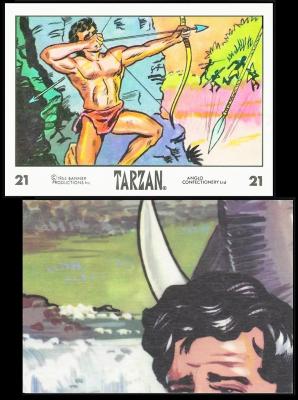
This starts our story at the very beginning, because all underwear began with a simple loincloth, as sported here by Tarzan, though technically his looks more like pants.
A true loincloth is named so because it is a long piece of cloth which is wrapped round the waist and either the front end, or both ends, are allowed to hang down in order to cover your nakedness.
However in some Asian areas the fabric passes between the legs and is tied, and I think this may be what the artist was thinking of when they drew this card.
This series is tied to a live action television series which was first screened on the NBC network in America in 1966, and ran, over two seasons and fifty-seven episodes, until 1968. And we know that because the series was produced by Banner Productions, whose name appears on these cards. We just do not know why they chose to make the cards art drawn and not feature stills from the production, though it may have been to save paying royalties to the actors.
The series was quite a lavish production, and it was filmed on location in Brazil and Mexico, usual for a film, but not so usual for a television series. In that series, Tarzan, who you may remember was raised in the jungle, tires of the Western World and returns to Africa. He was played by Ron Ely, who did most of his own stunts, and was injured through it, including being bitten, several times, by lions.
Oddly, this television Tarzan kept his chimpanzee companion, Cheeta, who was first paired with Johnny Weissmuller in 1932 - but there was no Jane in any of the episodes. Yet she had been part of the films since the first one, "Tarzan of the Apes", released in 1918, in which Tarzan was played by Elmo Lincoln and Jane by Enid Markey.
There were eight silent films/serials, including this one, the last of which was in 1929 released between 1918 and 1929. None of these seem to have been recorded on cards. In fact, the earliest set of cards featuring Tarzan is stated to be the 1934 set of fifty cards entitled "Tarzan and the Crystal Vault of Isis", issued by the Canadian Chewing Gum Company Ltd, and recorded by Jefferson Burdick as V.256. These same cards were also issued, in the same year, by the Schutter Johnson Candy Corporation, of Chicago, and Brooklyn, New York - and they are not that dissimilar to our card today, but this image does not appear. As far as the Crystal Vault of Isis, I cannot find this title as either a film nor a book. That set seems to have been inspired by the success of the first and second sound Tarzan films, starring Johnny Weissmuller, which were released in 1932 and 1934. They definitely had a Jane, Maureen O'Sullivan, who hit the headlines for her scanty attire - and some scenes had even been cut, pre-screening, on order of the censors.
The next set of Tarzan cards was the 1953, three-dimensional one, "Tarzan and the She-Devil", issued by Topps. They credit "Lesser Productions", which had been founded by Sol Lesser, and he had bought the screen rights to the Edgar Rice Burroughs character in 1933. He started to make a film almost immediately, starring Buster Crabbe, then Edgar Rice Burroughs' Tarzan character. A Tarzan the Fearless serial with screen newcomer Buster Crabbe resulted, but Burroughs, deciding to make his own Tarzan films, refused to renegotiate with Lesser. Burroughs's own movie enterprises were short-lived, and the rights passed to Metro-Goldwyn-Mayer. Burroughs sold Lesser options on all his Tarzan novels for seven years, with Lesser producing one Tarzan film a year for 20th Century-Fox. Only one Tarzan film was produced under this arrangement: Tarzan's Revenge (1938) featuring athletes Glenn Morris and Eleanor Holm. MGM objected to Lesser competing with its own Tarzan series, and Lesser agreed to sell the rights back to MGM.[3] When MGM relinquished the rights in 1942, Lesser regained the Tarzan property. Lesser's new Tarzan films were produced for RKO and starred Johnny Weissmuller and later Lex Barker and Gordon Scott, and Lesser devoted himself to these jungle adventures for the rest of his career. Lesser sold the Tarzan rights to producer Sy Weintraub in 1958, and retired.[4] "I had reached the age that one either finishes on top or far below. I decided I would end on top, and I was satisfied," he said.
Toward the end of his life he was actively involved in restoring many of his early productions, often in association with film preservationists at Blackhawk Films. Blackhawk reprinted many of Lesser's silent and sound films for the home-movie market.
Sol Lesser died in 1980, and was buried at Hillside Memorial Park in Culver City, California.
In our original British Trade Index part two, this is the last set to be listed under Anglo Confectionery, simply through them being in alphabetical order. And it is rather scantly described as :
- TARZAN. Lg. 90 x 65. Sectional back. Nd. (66) ... ANF-6
At that time we were still listing Anglo Confectionery cards separate from Anglo-American Chewing Gum Ltd., also of Halifax, and not including the anonymous cards. However, in our updated pre-1970 British Trade Index both these issuers are combined under "Anglo Confectionery Ltd., Halifax", and with a header that tells us "Anglo-American and Anglo Confectionery were the same firm. Issues began as Anglo-American, changed to Anglo Confectionery in the mid-1960s, who then issued up to 1974". Cards issued about 1955-74. In this listing, Anglo-American issues, where known, are identified by (AA) in brackets.". And because of that we do not yet have a home page for this issuer, we are waiting to feature the first set in alphabetical order in that list, which is "Animal World", as a Card of The Day.
Our set is described in that book as :
- TARZAN. 1967. 90 x 65. Nd. (66) Sectional back. ... ANG-370.
Tuesday, 5th August 2025
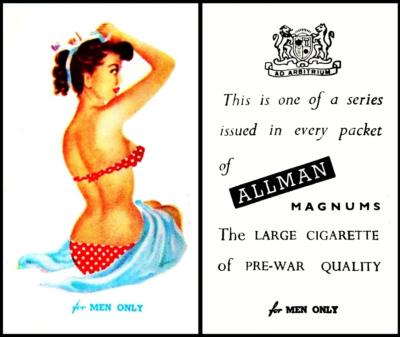
Now you may think that it is a very long leap from the loincloth to the bikini. And you may also remember that the bikini was named after an atomic bomb, with the designer comparing the devastating effects of the bomb to the effect that seeing a woman in a bikini would have on men.
The truth is that yes, the name "bikini" does date from 1946, the start of the atomic testing on and above the Bikini atoll, part of the Marshall Islands. However, a strip of cloth across the breasts of a woman is often seen, in accompaniment with a loincloth, in Greek frescoes, especially when women are depicted taking part in sporting events, and it is likely that it was designed for comfort during activity, much as we have a sports bra today. Whilst a similar costume is shown being worn by a goddess from the region that we today call Turkey, and even earlier, around 5600 B.C. - but this also begs the question that unless human women were known to wear such things, how would the painters have thought of one for their goddess ?
Strangely, after this, the bikini disappeared, for reasons of morality and such continued right until the Victorians, who still believed it unthinkable to emerge out of a bathing machines at the seaside without the equivalent of a long flannel nightgown.
It was the rise of women`s sport that changed this, though there was much resistance, and often police interference, to anyone who dared to push the boundaries. It was not until 1912 that the Summer Olympics, in Stockholm, Sweden, allowed women to compete in swimming for the first time - and that led to a rash of silent movies featuring mermaids, and also to the Sennett Bathing Beauties. Though Annette Kellerman, an Australian film star and swimming champion, had made several films in which she wore a one piece costume, and one, "A Daughter of the Gods", released in 1916, where she wore nothing, making her the first ever film star to appear on the screen in the nude - though extras and minor actresses had done so even before that.
The 1920s and 30s added the next change, for many reasons; the rise of sunbathing and outdoor living, the building of lidos and outdoor pools, and the simple fact that young people and women were at last having more of a say in how they were allowed to behave. This led to the one piece becoming shorter, sometimes cut out at the sides, and also beginning to shape into a "V" at the neck. Materials also helped with this, artificial ones like nylon, and the discovery that rubber was not only useful for tyres and other mechanical purposes. However all this changed with the start of the Second World War, when those new materials were needed for the war effort - and it changed because someone had the brilliant idea to save materials by making a complete two piece costume, with a strip of material removed right around the body between the bottom of the breasts and the waist.
Now we are back to where we began, to two men. One of these was called Jacques Heim, the owner of a beach supplies shop in Cannes, who called his tiny costume "Atome", not after a bomb, but because an atom was the smallest particle of material you could find in the galaxy. The other was Louis Reard, an engineer looking after his family lingerie business, he called his the bikini, and it was he who was the first man to cut the material below the navel, which was why it created such an effect, and got into so much trouble, being banned in several European countries, Australia and parts of America.
It was the French film star Brigitte Bardot, whose appearance, also at Cannes, re-introduced the bikini to a slightly more modern audience, and also led to its appearance in many 1960s movies, songs, and television. These included the James Bond films, and Raquel Welch sporting a fur bikini in "One Million Years B.C.", which, given the history of the garment that we have just uncovered, is no longer so far fetched an idea.
This set got a lot of bad press too, part of which was the idea that these were "Pin-Up Girls" - though that name did not appear on any of the cards. And using beauties to sell cigarettes was definitely nothing new. just check out the cards of beauties which were issued by "Melia", round about 1912, and it won`t be long before you find someone showing more of her assets than she really ought - and they are real photographs as well. Even earlier than that, especially in South America, you can get sets of women retiring to bed, gradually removing each piece of outer wear till just her skin remains.
This set is described in our original World Tobacco Issues Index as :
- PIN-UP GIRLS. (A) See X1/Ha.640 ... A41-2
A. Small, 68 x 40.
1. First 12 subjects :
(a) Front "For Men Only" - Unnumbered
(b) Front "Ask for Allman - always" - Unnumbered
(c) Front "Ask for Allman - always" - Numbered
2. Second 12 subjects. Front "Ask for Allman - always !" - Unnumbered
3. All 24 subjects. Back "First Series of 24" with offer of Art Reproductions. Numbered
B. Large, 75 x 68. Unnd. (24)
This text is identical in our updated World Tobacco Index, save the reference to X1.Ha.640, which is in the original handbook, and which has been replaced by H.640, which leads to the modern handbook. And, of course, a new card code, of A435-600.
The write up under X1.Ha.640 shows all the cards, albeit in black and white. I will scan that and set it in later. There is also a description, which reads :
- X1/Ha.640. PIN-UP GIRLS. (A) Issued by Philip ALLMAN & Co., as follows
A. Small size, 68 x 40 m/m
1. First 12 subjects, as illustrated in X1/Ha.640.1.
(a) Front "For Men Only" - Unnumbered
(b) Front "Ask for Allman - always" - Unnumbered
(c) Front "Ask for Allman - always" - Numbered
2. Second 12 subjects, as illustrated in X1/Ha.640.2. Front "Ask for Allman - always !" - Unnumbered
3. All 24 subjects. Back "First Series of 24" with offer of Art Reproductions. Numbered
B. Large size, 75 x 68 m/m. Unnumbered series of 24 (both illustrations).
Wednesday, 6th August 2025
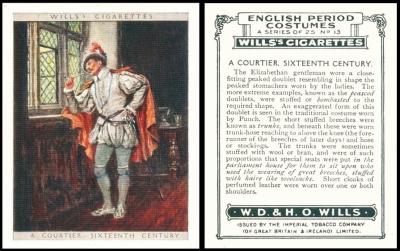
Strangely, for men, wearing a loincloth lasted for a very long time, and then, along came a kind of missing link, a type of woollen knee-length underpants/trousers looking like long cloth shorts. These came from Germany, brought across by invading armies, and they are still worn there, though they call them lederhosen. In fact we also wear them, longer, and know them as long-johns. However the Romans, who adopted them, for warmth, towards the end of their occupation of this country, called them "braccae", and the Celts borrowed this, and called them "braies". It is not hard to imagine how they also became known as breeches.
These were worn with a smock like top, and the top and the braies varied in size depending on whether you were well to do (in which case they fitted your form), or not (look at drawings of medieval farmers and you will see a flowing smock and baggy pants. Eventually, as you can see on our card, this led to the fashion for them to be so tightly formed around the legs that they resembled tights, at least amongst the rich, or those who hoped to pass themselves off as so. And this was enhanced by stripes, or ribbons around the knees.
Now this card is the large version of the home issue, but there are several other variants, including an anonymous version, issued through British American Tobacco, which we featured as our Card of the Day for the 12th of February, 2024. These differences and variations are admirably described in our original Wills reference book part IV as :
- 195. ENGLISH PERIOD COSTUMES. Fronts printed by letterpress in colour. Backs in grey, with descriptive text (except C).
Small cards, size 67 x 35 m/m. Series of 50
A. Home issue, Wills` name and I.T.C. Clause at base of back. Issued 1929.
B. General Overseas Issue, Anonymous backs, series title front and back.
C. General Overseas issue. Plain backs, unnumbered. Anonymous issue, series title front only.
D. MEDIUM cards, size 70 x 55 m/m. Series of 25. Inscribed "Wills World Renowned Cigarettes". Two grades of board (a) white semi-glossy (b) cream, matt. Issued in Australia 1928
E. LARGE cards, size 79 x 62 m/m. Series of 25. Home issue 1927.
The subjects in A-C are entirely different to those in D-E.
When the Wills part work books were reprinted into a single hard back volume, they included tables of dates of issue from the Wills` World Magazines, so we gained the month of issue for the home set, August 1929, and, also, very curiously, of our large version, which was issued almost two years earlier, in January 1927. However neither of the exported versions appear in this list, which means they were printed overseas.
By the time of our original World Tobacco Issues Index, the sets have been parted. The Home issue now appears under the Wills listings, section two, "Issues with I.T.C. Clause", and sub-section 2.B, for "Issues 1922-1939, exclusing adhesive backs." The text reads :
- ENGLISH PERIOD COSTUMES. Nd. See W/195.A ... W62-130
1. Small size (50)
2. Large size (25)
And that text is repeated in our updated World Tobacco Issues Index, just given a new card code of W675-168.
However, the large cards were not W/195.A, they were W/195.E - though that may be splitting hairs because you only need to look down the list to find them.
This is a list of the cards which are in this set, but any comparison with the Australian ones will have to be sorted out later - as will comparisons with the smaller sized sets - I am running late tonight.
- A Lady, Twelfth Century
- A Noble, Twelfth Century
- A Lady, Thirteenth Century
- A Painter, Thirteenth Century
- A Lady, Thirteenth Century
- A Sculptor, Fourteenth Century
- A Scholar, Fourteenth Century
- A Courtier, Fifteenth Century
- A Lady, Fifteenth Century
- A Merchant, Fifteenth Century
- A Courtier, Sixteenth Century
- A Lady, Sixteenth Century
- A Courtier, Sixteenth Century
- A Merchant`s Wife, Seventeenth Century
- A Lady, Seventeenth Century
- A Courtier, Seventeenth Century
- A Gentleman, Eighteenth Century
- A Gentleman, Eighteenth Century
- A Lady, Eighteenth Century
- A Lady, Eighteenth Century
- A Gentleman, Nineteenth Century
- A Gentleman, Nineteenth Century
- A Gentleman, Nineteenth Century
- A Lady, Nineteenth Century
- A Lady, Nineteenth Century
Thursday, 7th August 2025
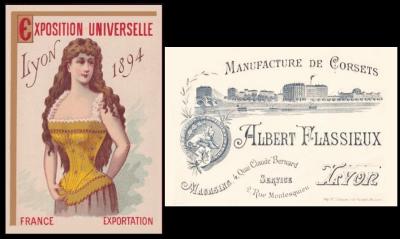
Underwear stayed almost the same until Victorian times, when the corset was re-invented - contorting and conforming the female body into a man`s ideal, and a shape it was never designed to make. It was not a new idea, and it appears that the Minoans used to wear them, both men and women, but we are not entirely sure why, though we think it was for ceremonial purposes rather than everyday wear.
As civilisation changed, and Europe became ruled ever more by the Church, the corset fell foul of censorship, for it enhanced the human body in every way. It was not until the sixteenth century, and only then in Italy, that a kind of corset returned to the clothing of the upper classes. It moved quickly into France and then to England, and it was soon intimately connected with the whaling industry, which supplied their surplus of bone in order to make the supporting framework. Sailors would also turn their hand to carving scenes on a particularly long piece of bone which would slide down the front to increase its rigidity.
The constriction really took off in the eighteenth century, when the corset started to be cut to an ever sharper shape and the lacing was developed so that it could be pulled tighter, once on the body, than it could ever be made. That pushed the ribs and stomach in so that the hips were enlarged. We are not sure why this was - though some social historians think it was to make it look like the women had larger hips than anywhere else and could therefore bear children more easily. However pushing the stomach in to such a degree actually had serious effects on the reproductive system.
The Victorian corset took this to the extreme, squeezing the female form so that the bust and hips were enhanced and the waist was like an hourglass centre in between. You can see this on our card, and how unnatural it looks.
This may have continued, if not for the First World War. When the women took over the jobs that men had been doing, most of which were strenuous, and involved lifting and stretching, there was no way that they could do that and wear a corset, so they abandoned them. And liked it. And after the war there were few women who wanted to put them on again.
They did make a comeback when movies started to feature stars with curvy shapes, in the late 1930s, but soon disappeared with the coming of the Second World War.
However, in recent times they have started to make a come back, thanks to popular culture, with movies, music, drag, burlesque, and the adult entertaiment industry all making lingerie acceptable as outer wear. Some say Madonna started it all, with the pink corset she wore on her "Blond Ambition" Tour of 1990 - but there were many before her, including the 1950s icon Bettie Page.
This card seems to have been given away at the Paris Exhibition, or, to give it its correct title "L`Exposition Universelle, Internationale et Coloniale" (or The World`s Fair, International and Colonial". It was held in Lyon, France, between the 29th of April and the 11th of November 1894. And today it is most famous not for bringing the nations together, but for the assassination of the French President, Marie Francois Sadi Carnot, on the 24th of June.
As for Albert Flassieux, I cannot find him, only that he is cited in the medallion table of the official guide - and you can see that, in its entirety, as a PDF in the Lyon Museum. He appears on page 6, under class XX, Articles de bonneterie et lingerie, (Hosiery and Corsetry), as having won a diploma with an honorable mention - as "Flassieux, 4, Quai Claude Bernard, Lyon", and that is the address on this card.
Friday, 8th August 2025
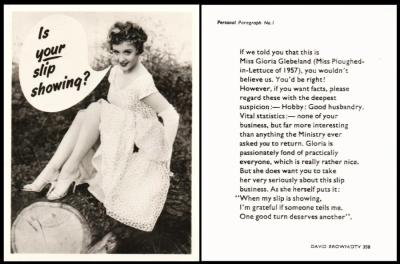
Now you may be surprised to hear that this card is not advertising underwear, but tractors. And the "slip" mentioned actually refers to the way that tractors can slide slowly sideways, making their ploughed furrows wider at one end than the other, wasting valuable growing land.
David Brown & Sons did not start out making tractors when they were founded in 1860, their first product being wooden gears for the local textile industry. It was not until the 1920s, when a distant descendant somehow got involved with a Mr. Ferguson, that tractors came along, namely the Ferguson-Brown. This was made in the factory at Huddersfield, and soon became much sought after within the farming community, not just because of its excellent manufacture, but because it came with a hydraulic lift and a three-point linkage. If you are not a tractor buff, that means that when you add an implement, i.e. a plough, to the tractor, you can secure it more firmly, and also raise and lower it not by hand, but by harnessing the power of hydraulics, which are both easier and faster.
For some reason, in the mid 1930s, this great team broke up, probably because the American market was more enticing to Mr. Ferguson, as he teamed up with Henry Ford. David Brown was not put off, and kept on making tractors, though he did move to a larger site at Meltham Mills, perhaps there had been some money involved with the break up. In 1939 his first solo tractor production was exhibited to much acclaim, at the Royal Show.
Sadly this was short lived, as with the coming of the Second World War his factory was taken over for war production and though he was still allowed to make tractors it was on the understanding that the Air Force would have priority on taking them. These were also slightly different, and constructed specially so that they could haul aircraft out to the runways, or bombs on trailers.
After the Second World War it took a while for things to return to normal. We know that in the mid 1950s Mr. Brown took over the "Albion" company, (actually Harrison, McGregor and Guest Ltd, of Leigh, Lancashire), who had making farm equipment since before the 1900s. This gave him a second, much needed, factory, too, which was as at that time he was big business, having contacts and interests in America, Australia, Canada, both Eire and Northern Ireland, Europe, and South Africa.
However, as the 1960s went on, in England there were changes; the countryside was beginning to recede, young people did not want to work on farms, they were too costly to run, and they had huge areas of land which were facing advances to be sold off to build houses and entire new towns on - and there was also much competition from other tractor companies, as well as a glut of second hand machines coming on to the market cheaply when farms folded and were sold at auction - and so the factory at Leigh was closed in the 1960s too.
Then, in the 1970s, David Brown was sold, to Tenneco of Houston, Texas, and merged with their subsidiary, the Case company, who, rather nicely, kept both names, as Case/David Brown.
This set was their only cartophilic issue. And I am rather fond of it, but mainly because of the way it is written up in "Bill" Wareham`s "Cartophily Britannia", which is such great fun. However this does call the date into question, because it was written up as part of the "New Issues - Collect Them Now" column, as part of issue No.17, volume 2, May 1959 - and also the number of cards quoted to comprise a full set. His write up is as follows :
- David Brown Ltd. 3 "IS YOUR SLIP SHOWING". Nd. 33 x 108 m/m. These real glossy black and white photos of a Miss Gloria Glebeland have real man appeal and no mistake. The young lady is shown in three different poses with her slip quite definitely showing. In each of the three pictures, Gloria is shown to be saying "Is your slip showing?". In one, the word "your" is underlined, in another the word "slip", and in the other, of course, "showing". Backs in grey are headed "Personal Paragraph No. 1, 2 or 3". Different pictures are found with different paragraphs on back, so it may be possible to collect nine different, though only five have so far been seen by us. Personal Paragraph No.2 reads : - "People who know Gloria Glebeland will say that she is not an easy girl to forget. Certainly she is not a girl who forgets easily. That`s why we knew she wouldn`t slip up about reminding you "Is your slip showing?". She means, of course, the invisible wheel-slip that can lose you as much as an acre of ploughing a day. If you want to know how to stop this, once and for all, ask us, not Gloria." From this, readers will realise that Brown`s are makers of gears employed in tractors and the cards are directed to users of same. Who said the farmers get no fun? Certainly not Gloria, ha, ha."
Before I continue to plough on, I have to say that, of course, this is not really a lady called Gloria Glebeland, the surname being a play on two farming words, "Glebe", and "Land", both meaning fields. The Gloria must have been chosen for her forename simply because of the alliteration. But as to why she really was, who knows; the photographer`s girlfriend wondering if she could become an actress - or an actress, wondering if she will ever become a star. If anyone recognises her, or knows more, do let us know.
Anyway, the set next appears in our original British Trade Index part two, slightly less humorously described, as :
David BROWN
Tractors. Reference to tractors occurs in Personal Paragraph on back.
- IS YOUR SLIP SHOWING? Lg. 109 x 83. Black glossy photos of Gloria Glebeland. Back inscribed at top right "Personal Paragraph No. ...", at base "David Brown/DTV 358". Nd. (3). ... BRP-1
Whilst in our updated British Trade Index it is catalogued as :
David BROWN
Tractors. Indicated on backs. Issued 1954..
- IS YOUR SLIP SHOWING? 109 x 83. Black glossy photos of Gloria Glebeland. Nd. (3). ... BRO-670
well the last two are a bit sparse but tomorrow they will be expanded - and all the info from the research books will be in place. I did much better than I thought, in a week that was pretty full on. I will just say that if any readers work for 111, thank you for being there, and sorry for calling quite so many times.
Its late, I`m tired, and I have not had my 9 pm hot chocolate. I intend to sort that out now, as my rather lairy pink kettle is here with me, full of water, and ready to go. And I also have a chocolate biscuit. After that I will head to sleep, and hope not to be summoned by the sound of someone falling out of bed, down the stairs, in the kitchen, or off the sofa. Again...
Next week I shall return, and hopefully with more time. Have a great week, and I wish that you hopefully find some cards, or some information, that you have been hunting for some time. I bought a card this week, but if I want to get to sleep I shall not think of it, for it is, like the Maltese Falcon, the stuff, for sure, of which my dreams are made.
Good night, Mary Ellen.
